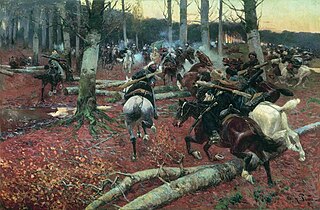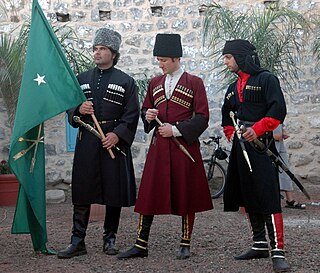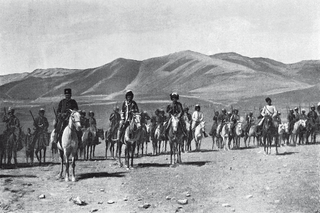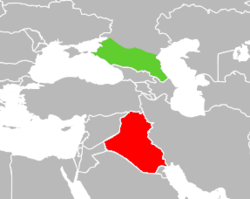
Kirkuk is a city in Iraq, serving as the capital of the Kirkuk Governorate, located 238 kilometres north of Baghdad. The city is home to a diverse population of Kurds, Turkmens and Arabs. Kirkuk sits on the ruins of the original Kirkuk Citadel which sits near the Khasa River.
The Nart sagas are a series of tales originating from the North Caucasus. They form much of the basic mythology of the ethnic groups in the area, including Abazin, Abkhaz, Circassian, Ossetian and to some extent Chechen-Ingush folklore.

Circassia, also known as Zichia, was a country and a historical region in the North Caucasus along the northeast shore of the Black Sea. It was conquered and occupied by Russia during the Russo-Circassian War (1763–1864), after which 90% of the Circassian people were either exiled from the region or massacred in the Circassian genocide.

Circassians, also called Cherkess or Adyghe, are an indigenous Northwest Caucasian ethnic group and nation native to the historical country-region of Circassia in the North Caucasus. As a consequence of the Circassian genocide perpetrated by the Russian Empire in the 19th century during the Russo-Circassian War, most Circassians were exiled from their homeland in Circassia to modern-day Turkey and the rest of the Middle East, where most of them are today. In the early 1990s, the Unrepresented Nations and Peoples Organization estimated that there are as many as 3.7 million Circassians in diaspora in over 50 countries.

Adyghe is a Northwest Caucasian language spoken by the western subgroups of Circassians. It is spoken mainly in Russia, as well as in Turkey, Jordan, Syria and Israel, where Circassians settled after the Circassian genocide. It is closely related to the Kabardian language, though some reject the distinction between the two languages in favor of both being dialects of a unitary Circassian language.

The Caucasian languages comprise a large and extremely varied array of languages spoken by more than ten million people in and around the Caucasus Mountains, which lie between the Black Sea and the Caspian Sea.

The Chechens, historically also known as Kisti and Durdzuks, are a Northeast Caucasian ethnic group of the Nakh peoples native to the North Caucasus. They are the largest ethnic group of the North Caucasus and refer to themselves as Nokhchiy. The endonym Nokhchiy is thought to be derived from the name of Prophet Noah and it means 'descendant(s) of Noah'. The vast majority of Chechens are Muslims and live in Chechnya, a republic of Russia.

The Ubykh are one of the twelve major Circassian tribes, represented by one of the twelve stars on the green-and-gold Circassian flag. Along with the Natukhai and Shapsug tribes, the Ubykh were one of three coastal Circassian tribes to form the Circassian Assembly in 1860. Historically, they spoke a distinct Ubykh language, which never existed in written form and went extinct in 1992 when Tevfik Esenç, the last speaker, died.

Kurmanji, also termed Northern Kurdish, is the northernmost of the Kurdish languages, spoken predominantly in southeast Turkey, northwest and northeast Iran, northern Iraq, northern Syria and the Caucasus and Khorasan regions. It is the most widely spoken form of Kurdish.

The Caucasian War or Caucasus War was a 19th-century military conflict between the Russian Empire and various peoples of the North Caucasus who resisted subjugation during the Russian conquest of the Caucasus. It consisted of a series of military actions waged by the Russian Imperial Army and Cossack settlers against the native inhabitants such as the Adyghe, Abaza–Abkhaz, Ubykhs, Chechens, and Dagestanis as the Tsars sought to expand.

The peoples of the Caucasus, or Caucasians, are a diverse group comprising more than 50 ethnic groups throughout the Caucasus.

Kurdification is a cultural change in which people, territory, or language become Kurdish. This can happen both naturally or as a deliberate government policy.

The Shapsug are one of the twelve major Circassian tribes. Historically, the Shapsug tribe comprised one of the largest groups of the Black Sea Adyghe. They inhabited the region between the Dzhubga River and the Shakhe Rivers and high-altitude mountainous areas of the northern slopes of the Caucasus range along the Antkhir, Abin, Afips, Bakan, Ships, and other rivers . In Russia, the remaining Shapsug population mainly live in the Tuapsinsky District (Tuapse) of Krasnodar Krai, Lazarevsky City District of Sochi, and in the Republic of Adygea, which were a small part of historical Circassia.

Circassian nationalism is the desire among Circassians worldwide to preserve their culture, save their language from extinction, raise awareness about the Circassian genocide, return to Circassia and establish a completely autonomous or independent Circassian state in its pre-Russian invasion borders.

Circassians in Israel are Israelis who are ethnic Circassians. They are a branch of the Circassian diaspora, which was formed as a consequence of the 19th-century Circassian genocide that was carried out by the Russian Empire during the Russo-Circassian War; Circassians are a Northwest Caucasian ethnic group who natively speak the Circassian languages and originate from the historical country-region of Circassia in the North Caucasus. The majority of Circassians in Israel are Muslims.
Amjad Jaimoukha was a Circassian writer, publicist and historian, who wrote a number of books on North Caucasian – specifically Circassian and Chechen – culture and folklore. According to the Circassian Encyclopaedia, "Jaimoukha was perhaps the most important writer on Circassian issues." In particular, he was active in promoting and assisting a new crop of Circassian and non-Circassian writers working on raising the profile of Caucasian issues at the global level.

The Circassian diaspora refers to ethnic Circassian people around the world who live outside their homeland Circassia. The majority of the Circassians live in the diaspora, as their ancestors were settled during the resettlement of the Circassian population, especially during the late nineteenth and early twentieth century. From 1763 to 1864, the Circassians fought against the Russian Empire in the Russian-Circassian War, finally succumbing to a scorched-earth genocide campaign initiated between 1862 and 1864. Afterwards, large numbers of Circassians were exiled and deported to the Ottoman Empire and other nearby regions; others were resettled in Russia far from their home territories. Circassians live in more than fifty countries, besides the Republic of Adygea. Total population estimates differ: according to some sources, some two million live in Turkey, Jordan, Syria, and Iraq; other sources have between one and four million in Turkey alone.

Chechen Kurds or Kurdified Chechens are ethnic Chechens who went through a process of Kurdification after fleeing to Kurdistan during and after the Russian conquest of the Caucasus in the 1860s. Today, these Chechens are perceived as being of the "Chechen tribe" and "Lezgî tribe".

Circassians in Jordan are Circassians living in Jordan. Circassian refugees arrived in Jordan in the late 19th century, after being exiled during the Circassian genocide in the 1860s and later the Russo-Turkish War (1877–1878). They settled in Jordan, then a part of Ottoman Syria, in and around Amman and Jerash. Circassians are credited with founding modern Amman as the city had been previously abandoned.




















